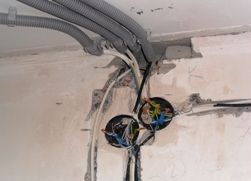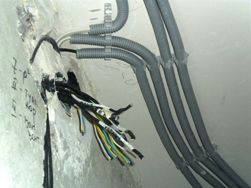Categories: Featured Articles » Electrician at home
Number of views: 130671
Comments on the article: 4
Concealed wiring
Requirements for hidden wiring, necessary materials and equipment, installation features.
 It should be noted that there is simply no clear and unambiguous separation of electrical wiring into hidden and open. There are two different opinions: some consider hidden only that wiring, the route of which is not visible, it is impossible to trace. At the same time, others believe that wiring in tubes and cable channels should also be classified as hidden, because the cable is not visible, and it is mechanically protected.
It should be noted that there is simply no clear and unambiguous separation of electrical wiring into hidden and open. There are two different opinions: some consider hidden only that wiring, the route of which is not visible, it is impossible to trace. At the same time, others believe that wiring in tubes and cable channels should also be classified as hidden, because the cable is not visible, and it is mechanically protected.
We will not break copies on this subject. Let's talk only about the wiring, which everyone considers hidden. According to the method of laying the cable, it can be divided into wiring, paved in strobes, and for wiring mounted under any sheathing. In one room, these methods of cable laying can very well be combined.
Well, and, of course, a number of requirements are imposed on hidden electrical wiring, each of which we will try to dwell on in detail.
Hidden or open wiring - what's better?
Concealed cable wiring
Pros:
-
no wires are visible behind the layer of gypsum or cement, which not only reliably conceals the cable, but also serves as a good dielectric, provided that the plaster is dry.
Minuses:
-
if the circuit is damaged, it is extremely difficult to find out exactly where the break or leak occurred;
-
it’s difficult to get to the wire, because for this you have to remove the ceramic tile or wallpaper, which means that after repair you need to make repairs, which requires a lot of money.
Open cable wiring
Pros:
-
it’s easy to get to the wiring, and you don’t have to remove the tile or wallpaper, and then make repairs.
Minuses:
-
conductors are visible, which is not quite aesthetically pleasing; open wiring is easier to damage than hidden.
Hidden Wiring Requirements
The first and most important requirement is fire safety requirement. Because of this requirement, hidden wiring in a wooden house under the inner lining must be carried out in steel or PVC pipes. In brick and concrete houses, electrical wiring must either be terminated in a strob or mounted in a corrugated pipe for a covering from sheets of gypsum plasterboard, gypsum fiber board, LSU or plywood.
The next requirement is providing wiring interchangeability. The idea here is to leave the possibility of replacing and adding cables without having to remove the wall sheathing and produce any damage. But, unfortunately, this wonderful requirement is often forcibly not respected. After all, it is very rarely possible to pierce a wall in a wall sufficient to lay a whole pipe. Therefore, for changeability, often only a pipe or corrugated pipe remains behind the casing, and pipes for electrical wiring laid under the floors.
As soon as the wiring is hidden, one specific requirement is presented to it, which subsequently facilitates its operation. This requirement applies to the route of the cable route. During installation, there is always some temptation to lay the cable as you like: somewhere diagonally, somewhere horizontally in the middle of the wall. This can save time and materials. However, it is better to remember that all cable crossings must be carried out either in a strict vertical direction or horizontally under the ceiling or at a height of 2.5 meters. This is for posting on walls. If the wiring is made under the floor, then the cable must always run parallel to any pair of walls.
 Compliance with this requirement will further facilitate the presentation of cable paths. After all, it will not be visible, and the walls will be drilled occasionally, the floor may also make its way, and damage to the cable is easy.
Compliance with this requirement will further facilitate the presentation of cable paths. After all, it will not be visible, and the walls will be drilled occasionally, the floor may also make its way, and damage to the cable is easy.
For the same reasons Before installing the hidden wiring, it will be useful to draw up a detailed plan with the location of all branch boxes. The plan will be mandatory for execution and subsequent storage.
For hidden wiring, as well as for open, not in the last place it is worth electrical safety. Accordingly, the presence of a third conductor (PE) in the line for the device of the TN-S or TN-C-S system is mandatory. If the connection of the PE conductor is impossible due to the lack of an appropriate trunk wire in the access panel, then it is better to run the cable line with three wires anyway, and the yellow-green wire should not be connected anywhere until better times.
Also, for electrical safety reasons, as part of a hidden electrical wiring, we provide RCD or differential circuit breakers for rooms with increased danger (bathroom, kitchen), we are developing a potential equalization system.
Materials and equipment for hidden electrical wiring
The cable for hidden wiring will fit the most ordinary - VVGng. If you are not confused by the large financial costs, you can perform installation with NYM cable. Both VVG and NYM have a long enough standard service life so that for decades with hidden wiring there will be no headache. At the same time, their insulation is strong enough to easily withstand even wet embedment in a strob.
The cable section for flush wiring is chosen standard: for lighting circuits - 1.5 sq. mm, for outlet networks - 2.5 square meters. mm., and for an electric stove 4 square meters will be enough. mm Deviations from these norms are extremely rare.
Switchboards absolutely any are suitable for hidden wiring, including those formally designed for open wiring. The same, in principle, can be said of switches with sockets. However, sockets and switches for hidden wiring look better and take up less space, so it is better to give preference to them. They will also need special socket boxes for the same hidden wiring: for installation in solid or hollow walls.
Junction boxes For flush wiring, there are also two modifications - for solid and for hollow walls.
Features of installing hidden electrical wiring
The main feature of installing hidden electrical wiring is most often the need for gating. This is a very dirty, noisy and time-consuming procedure that must be carried out at the very initial stage of the repair of the room. At the same stage, it is necessary to pierce the crowns for openings for branching boxes and branch boxes.
The next important step in the installation of hidden wiring will be the fastening of cable harnesses in the gates with dowels, mounting strip or alabaster mortar. Podrozetniki and branch boxes are mounted in solid walls with plaster or alabaster as well.
For covert wiring in pipes, gating is excluded. Instead, it will be installing pipes using clamps, mounting plates, linings or clips. The cable can be pulled through the pipe both before and after its installation, depending on which is more convenient.
Regardless of how and in what we install the cable, it is necessary to mark the ends so as not to get confused while connecting them in the boxes.
After pulling the cables, installing the socket boxes and branch boxes, the installation of the hidden electrical wiring loses all its specifics: the usual connection of the ends, the connection of devices, sockets and switches and a trial run.
Read more on this topic here: How to install hidden electrical wiring in the home

See also at bgv.electricianexp.com
:
